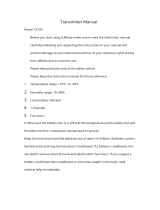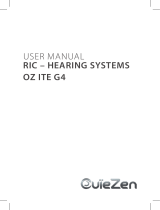Page is loading ...

Pure, Pure SE
User Guide

2

3
Content
Content
Your Pure hearing instrument 4
Intended use 6
General notes on safety 7
Handling batteries 10
Inserting and removing your hearing instrument 12
Turning your hearing instrument on and off 14
Changing the hearing program 15
Changing the volume 16
Functionalities 17
Maintenance and care 18
Accessories 24
Troubleshooting 26
Technical information 27
Disposal information 29
Your hearing instrument configuration 30

Your Pure hearing instrument
4
Pure Pure SE
battery type 312
rechargeable
battery type 10
non-rechargeable
① Receiver unit
② Dome
③ Charging contacts
④ Battery compartment
⑤ Microphone cover
⑥ Microphone openings
⑦ Push button
⑧ Receiver mold
⑨ Custom shell
⑩ Serial number
⑪ Type of hearing
instrument
Your Pure hearing instrument

Your Pure hearing instrument
5
EN
Your Hearing Care Professional offers an assortment of
receiver lengths and dome sizes to fit your ear best.

Intended use
6
Hearing instruments are intended to improve the hearing
of hearing impaired persons. Diagnosis and prescription
of a hearing instrument must be performed by hearing
health specialists, e.g. ENT doctors, audiologists or
acousticians.
Read and follow the instructions of this user guide to
avoid injuries or damage to the hearing instruments.
Symbols:
Be aware to information marked with the warning symbol
WARNING, CAUTION or NOTICE!
WARNING points out a situation that could
lead to serious injuries, CAUTION indicates a
situation that could lead to minor and moder-
ate injuries.
NOTICE NOTICE indicates possible property damage.
Advice and tips on how to handle your device
better.
Instruction. Indicates that something has to be
done.
Indicates an option that not every hearing
instrument has. Ask your Hearing Care Profes-
sional to check off the relevant information.
Intended use

General notes on safety
7
EN
NOTICE
Your hearing instruments are sensitive to ex-
treme heat, high humidity, strong magnetic fields
(> 0.1T), X-rays and mechanical stress.
Do not expose your hearing instruments to
extreme temperature or high humidity.
Do not leave them in direct sunlight.
Do not wear them in the shower or when you
apply make-up, perfume, aftershave, hairspray
or suntan lotion.
Do not wear your hearing instruments when
you are exposed to short-waves, a strong mag-
netic field, a high frequency field or X-rays.
Do not place your hearing instruments in a
microwave oven.
General notes on safety

General notes on safety
8
WARNING
Choking hazard posed by small parts.
Keep hearing instruments, batteries and acces-
sories out of children‘s reach.
If swallowed consult a physician or hospital im-
mediately.
These hearing instruments are not designed for
children under the age of 36 month or mentally
disabled persons.
Siemens offers special hearing instruments for the
fitting of infants and small children.
Ask your Hearing Care Professional for further
information.
WARNING
Hazard of explosion in explosive atmospheres!
Do not use your hearing instruments in areas
where there is a danger of explosions (e.g. min-
ing area).

General notes on safety
9
EN
NOTICE
Leaking batteries damage the hearing instruments.
Turn the hearing instruments off when not in
use to preserve the battery.
Remove batteries when the instruments are not
in use for a prolonged period of time.
NOTICE
Batteries contain harmful substances that pollute
the environment.
Do not throw used batteries into household
trash.
Dispose batteries according to national regu-
lations or return them to your Hearing Care
Professional.
In some countries restrictions for the usage of
wireless equipment exist.
Refer to local authorities for further informa-
tion.

Handling batteries
10
original size
Always use the right size batteries.
Charge the rechargeable batteries before first
use.
Remove the tab on standard batteries only
when you are ready to use them.
The positive (+) side of the batteries is always
the smooth side.
Always keep spare batteries with you.
Low battery indicator
Your Hearing Care Professional can activate an acoustic
signal to inform you when the battery is nearly empty. If
you hear an acoustic signal or experience low amplifica-
tion power, replace the battery.
Handling batteries

Handling batteries
11
EN
Inserting the battery
Open the battery compartment complete-
ly using your fingernail as shown in the
illustration.
Insert the proper size battery.
Make sure that the "+" symbol on the bat-
tery points up as shown in the picture
Close the battery compartment.
Do not force the door shut. If it does not
close easily, check to see if the battery
was inserted properly.
When the battery door is completely closed,
your hearing instrument is ready for use.
Removing the battery
Open the battery compartment completely.
Normally the battery drops out when the
compartment is completely open.
If the battery does not come out, lightly
tap the instrument or use the magnet
stick available as accessory to remove
the battery.

Inserting and removing your hearing instrument
12
For side recognition ask your Hearing Care
Professional to apply colored markers in the bat-
tery compartment. If the marker in the battery
compartment is in red, the hearing instrument is
intended for the right ear. If the marker is in blue,
the hearing instrument is for the left ear.
Inserting your hearing instrument
Turn your hearing instrument off.
Hold the dome/receiver mold/
custom shell between your
thumb and index finger and in-
sert it carefully into the ear canal.
You may find it helpful to pull
your ear slightly upward or to the
back.
Place your hearing instrument behind the ear.
Turn your hearing instrument on.
Inserting and removing your
hearing instrument

Inserting and removing your hearing instrument
13
EN
Removing your hearing instrument
Hold the dome/receiver mold/
custom shell between your
thumb and index finger and care-
fully pull it out.
You may find it helpful to lightly
push your ear from the back.
The custom shell can be removed by pulling the
small removal cord toward the back of your head.

Turning your hearing instrument on and off
14
Via battery compartment
O n
Close the battery compartment.
Off
Open the battery compartment.
Via push button
O n
Press the push button for
2 seconds.
Off
Press the push button for
2 seconds.
Via remote control
Refer to the remote control user guide.
Turning your hearing instrument
on and off

15
EN
Changing the hearing program
Via push button
Press the push button.
The hearing instrument changes
to the next program.
Via remote control
Refer to the remote control user guide.
Changing the hearing program

Changing the volume
16
The volume of your hearing instruments is controlled
automatically and there is no need to manually adjust it.
Should you prefer manual volume control, your Hearing
Care Professional can program the hearing instrument for
manual adjustment.
Automatic
The volume is adjusted automatically when in use.
Via remote control
Refer to the remote control user guide.
Changing the volume

Functionalities
17
EN
Your Hearing Care Professional can activate the following
functionalities.
e2e wireless
■ Allows the use of a remote control.
■ Automatically adjusts both hearing instruments
simultaneously to change the instrument set-
tings, e.g. volume or program.
The performance of the wireless function
may be affected by electromagnetic inter-
ference – e.g. from a computer monitor or
fluorescent lamp system.
Move away from the source of interfer-
ence if you experience difficulty.
Power-on delay
Your hearing instrument is equipped with a "power-
on delay" feature which can be activated by your
Hearing Care Professional. This allows you to turn
the hearing instrument on with an automatic delay
of 6/12/18 seconds, so that you may insert the hear-
ing instrument into your ear without experiencing
unpleasant feedback (whistling).
Functionalities

Maintenance and care
18
Your hearing instruments are highly sensitive systems.
Proper care and handling will ensure the best possible
performance.
Clean instruments regularly to prevent damage to the
hearing instruments and to avoid health problems.
NOTICE
Do not put your hearing instruments
in water.
Clean your hearing instruments with a soft, dry tissue,
as necessary.
If the hearing instruments sound distorted or weak ask
your Hearing Care Professional to exchange the micro-
phone cover.
Place your hearing instruments in a "dry aid kit" with a
special moisture-attracting capsule overnight.
Ask your Hearing Care Professional for special care sets
and further information on how to keep your hearing
instruments in good condition.
Maintenance and care

Maintenance and care
19
EN
Domes, receiver molds, and custom shells
CAUTION
Risk of injury caused by incorrect use of receiver
unit and domes/receiver molds/custom shells.
Always wear the receiver unit with a dome or
receiver mold.
Make sure that the dome/receiver mold is com-
pletely attached to the receiver unit.
If the dome/receiver mold/custom shell remains
in your ear, have it removed by a medical pro-
fessional.
Insert the receiver unit with the dome/receiver
mold/custom shell carefully and not too deeply
into the ear.
Use the receiver unit and the dome/receiver
mold/custom shell only as described in this user
guide.

Maintenance and care
20
Your hearing instruments have one of the following ear
pieces:
Single
dome
Double
dome
Receiver
mold
Custom shell
Cleaning domes, receiver molds, and custom shells
Cerumen (ear wax) on the dome/receiver mold/custom
shell affects sound quality.
Clean domes/receiver molds/custom shells right after
taking the hearing instruments
off.
This way, cerumen can not dry
and harden.
Remove cerumen with a soft tis-
sue. No other tools are required.
To remove dried cerumen, moist-
en the soft tissue with a cerumen
solvent. Dab the cerumen with
the moistened tissue and wait a
short period of time.
This will loosen the cerumen.
/








